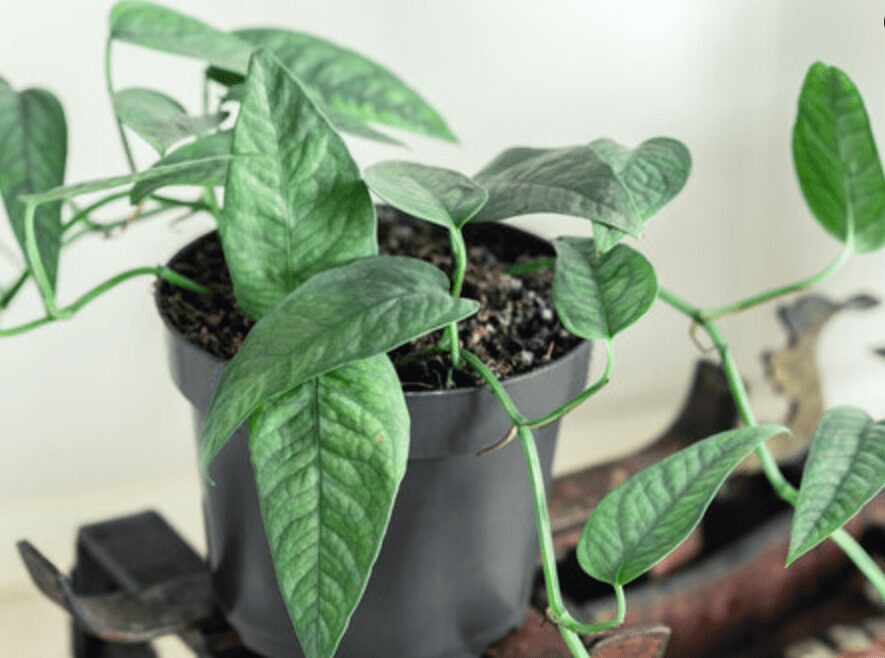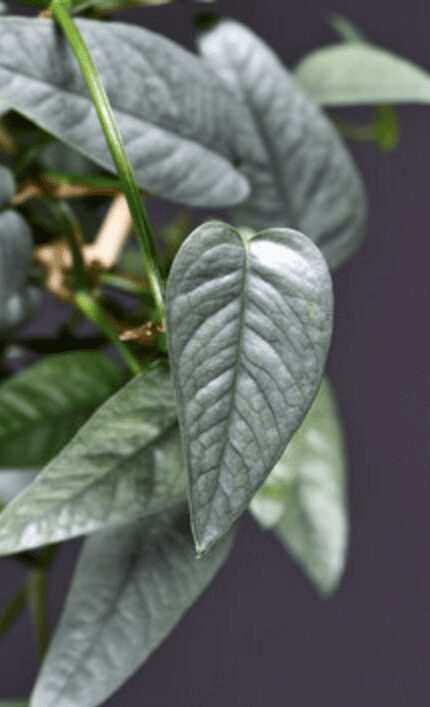
Cebu Blue Pothos, also known as Epipremnum pinnatum ‘Cebu Blue,’ is a tropical plant native to Southeast Asia. This plant has become increasingly popular indoors because of its easy-care nature, beautiful appearance, and air-purifying qualities.
It is an excellent addition to any home or office as it is low maintenance and can add beauty to any space.
Characteristics of Cebu Blue Pothos
Cebu Blue Pothos is a vine that can grow up to 10 feet long, making it an excellent plant for hanging baskets or draping over furniture. The leaves of this plant are a striking shade of blue-green with a satin-like finish.
When exposed to brighter light, the leaves can turn darker, creating a beautiful contrast against the light-colored stems.
Caring
Cebu Blue Pothos is a low-maintenance plant, making it an excellent choice for beginners or those too busy to care for pothos plants regularly. Here are some tips for caring for your CB Pothos:
Light
Cebu Blue Pothos prefers bright, indirect light but can also tolerate low light conditions. Direct sunlight can scorch the leaves, so avoiding placing the plant in direct sunlight is best.
Water
The CB Pothos prefers to be kept evenly moist but can also tolerate periods of drought. Water the plant when the top inch of soil feels dry. Overwatering can lead to root rot, so make sure the plant is not sitting in water.
Humidity
This Pothos prefers high humidity but tolerates normal household humidity levels. If the air in your home is dry, you can increase the humidity by placing a humidifier near the plant or a tray of water near the plant.
Temperature
It prefers temperatures between 60-85°F (15-29°C) and can tolerate temperatures as low as 50°F (10°C).
Fertilize
To fertilize it, you can use a balanced, water-soluble fertilizer with an N-P-K ratio of 20-20-20 or 10-10-10. You can dilute the fertilizer according to the instructions on the package, usually one tablespoon per gallon of water, and apply it to the soil around the base of the plant.
Alternatively, you can use organic fertilizers such as compost or worm castings. These can be added to the soil surface around the plant and watered in.
It’s important not to over-fertilize your Cebu Blue Pothos, which can lead to burnt leaves or root damage. Fertilize your plant once a month during the growing season (spring and summer) and reduce the frequency to every two to three months during the dormant season (fall and winter).
Soil
Cebu Blue Pothos prefers well-draining soil, such as a mix of potting soil, perlite, and sand.

Propagating
Cebu Blue Pothos is easy to propagate and is an excellent plant for beginners looking to try their hand at propagation. Here are some tips for propagating:
Stem Cuttings
- Choose a healthy and mature Cebu Blue Pothos plant stem with at least 2-3 leaves.
- Cut the stem below a node using a clean and sharp pair of scissors or pruning shears (a small bump on the branch where the leaves grow out from).
- Remove leaves from the stem’s lower half, leaving only the top leaves intact.
- Fill a small container with water and place the stem cutting into the water, ensuring that the bottom half of the stem is submerged.
- Place the container in a bright and warm location but out of direct sunlight. Change the water every few days to keep it fresh and oxygenated.
- After a few weeks, you should see roots forming on the bottom of the stem cutting. Once the roots are at least an inch long, you can transplant the cutting into a pot filled with well-draining soil.
- Water the newly potted cutting thoroughly and place it in a bright, indirect light location. Keep the soil moist but not waterlogged, and avoid overwatering.
Division
- Choose a mature Cebu Blue Pothos plant with several stems at least a few years old.
- Carefully remove the plant from its pot and gently loosen the soil around the roots.
- Look for natural divisions in the plant where the stems are growing from separate root systems. You can also create divisions by gently pulling apart the stems and roots.
- Once you have identified the divisions, carefully separate them from each other using a clean and sharp pair of scissors or pruning shears.
- Each division should have its own stem(s) and a healthy root system.
- Plant each division in a pot filled with well-draining soil. Ensure the roots are covered with soil and the stem(s) are above the soil line.
- Water the newly potted divisions thoroughly and place them in a bright, indirect light location. Keep the soil moist but not waterlogged, and avoid overwatering.
Decorating with Cebu Blue Pothos
Cebu Blue Pothos is a versatile plant that can add beauty to any space. Here are some ideas for decorating with it:
- Hanging baskets: Cebu Blue Pothos is an excellent plant for hanging baskets. The long, trailing vines can add a touch of greenery to any room.
- Wall decor: You can create a living wall by hanging multiple Cebu Blue Pothos plants on a wall. This can add a unique touch to any space and can also help purify the air.
- Tabletop decor: Cebu Blue Pothos can be used as tabletop decor by placing it in a decorative pot or vase. You can also place it on a plant stand or bookshelf for added height.
Frequently Asked Questions
What is Cebu Blue Pothos and where does it come from?
Cebu Blue Pothos, also known as Epipremnum pinnatum ‘Cebu Blue’, is a popular houseplant from the Araceae family. It is native to the Solomon Islands and can also be found in other parts of the Pacific Islands.
What are the benefits of having a Cebu Blue Pothos plant?
Cebu Blue Pothos is a beautiful addition to any indoor space and has air-purifying properties that can help improve indoor air quality. It is also easy to care for and can tolerate low-light conditions.
How do I care for my Cebu Blue Pothos plant?
Cebu Blue Pothos prefers bright, indirect light but can tolerate low-light conditions. It also prefers well-draining soil and should be watered when the top inch of soil is dry to the touch. It can also benefit from occasional fertilization during the growing season.
Can Cebu Blue Pothos be propagated?
Yes, Cebu Blue Pothos can be propagated through stem cuttings or division. Stem cuttings can be rooted in water or soil, while division involves separating a mature plant into smaller sections with their own stem(s) and root system.
Is Cebu Blue Pothos toxic to pets?
Cebu Blue Pothos contains calcium oxalate crystals, which can cause irritation and swelling of the mouth, tongue, and throat if ingested by pets. Keeping the plant out of reach of pets and small children is recommended.
How fast does Cebu Blue Pothos grow?
Cebu Blue Pothos is a fast-growing plant and can produce long trailing stems if given proper care and growing conditions. It can grow up to several feet long if left to its own devices.
Does Cebu Blue Pothos require pruning?
Cebu Blue Pothos does not require pruning but can benefit from occasional trimming to control its size and shape. Pruning can also help encourage bushier growth and prevent the plant from becoming too leggy.
How do I propagate my Cebu Blue Pothos plant?
As mentioned earlier, two standard methods for propagating Cebu Blue Pothos are stem cuttings and division. Stem cuttings involve cutting a stem with at least 2-3 leaves and rooting it in water or soil. Division involves separating a mature plant into smaller sections, each with its stem(s) and root system.
Can Cebu Blue Pothos be grown outdoors?
Cebu Blue Pothos is a tropical plant that thrives in warm, humid conditions. It can be grown outdoors in warm and humid climates, such as the Southern United States, but it should be protected from direct sunlight and cold temperatures.
Why are the leaves of my Blue Pothos turning yellow?
Yellowing leaves on Cebu Blue Pothos can indicate overwatering or underwatering, poor soil drainage, or a lack of nutrients. It is essential to check the soil moisture levels, adjust watering frequency, and ensure the plant is planted in well-draining soil. Fertilizing the plant with a balanced fertilizer can also help provide the necessary nutrients for healthy growth.
How do I care for a Cebu Blue Pothos in the winter?
This Pothos can be more sensitive to cold temperatures and dry indoor air during winter. It is important to keep the
Conclusion
Cebu Blue Pothos is an excellent plant for those who want to add beauty to their space without much maintenance. This plant is easy to care for, versatile, and can add a touch of greenery to any room. With the tips and ideas provided in this article, you can decorate with Cebu Blue Pothos and enjoy its many benefits.


























